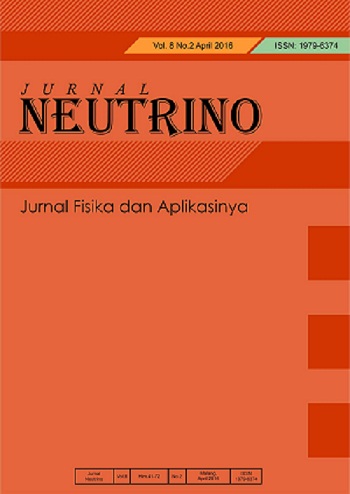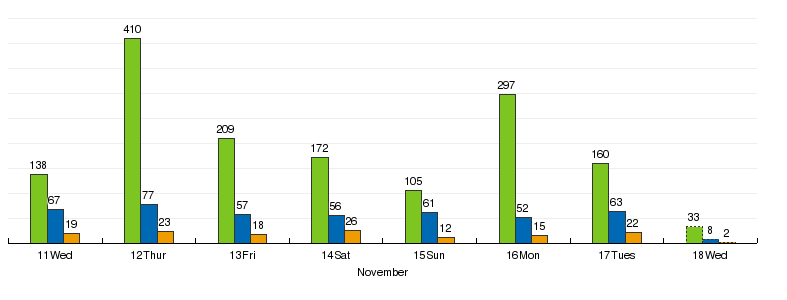THE EFFECT OF NANO ZnO MORPHOLOGY ON STRUCTURE, DIELECTRIC CONSTANT, AND DISSIPATION FACTOR OF CA-NANO ZnO/ITO FILMS
Abstract
Research to utilize natural polymers continues to be driven primarily by utilization as an environmental friendly energy-generating and storage material. The high porosity makes cellulose acetate (CA) a good candidate as a dielectric material as the basis of the supercapacitor device. Various dopants and compositions have been widely used, but the nano size morphological differences of the same material are rarely reported. Two types of ZnO are prepared, i.e., nanoparticles and nanorods deposited with CA and deposited on ITO glass substrate. The CA-ZnO / ITO composite film was fabricated through spin coating technique. This study focused on ZnO morphological difference on the microstructure and the dielectricity of CA-ZnO /ITO composite films. The morphology of nanoparticles and nanorods of ZnO were analyzed more detail with respect to its microstructure and dielectric properties. It is revealed that the change of ZnO morphology from nanoparticles to nanorod increase the capacitance and dielectric constant significantly from the order of the nano to the micro and decrease the dielectric loss. The dielectric constant of CA-ZnONP/ITO and CA-ZnONR/ITO are respectively of 2569 and 97159 at 100 Hz. The capacitance and dielectric loss of CA-ZnONP/ITO and CA-ZnONR/ITO reach to 69.809 nF; 678 and 2,15765 µF; 13,23 respectively.
Keywords
Full Text:
PDFReferences
Li, Q. et al. from polymer nanocomposites. LETTER (2015). doi:10.1038/nature14647
Shen, Y., Zhang, X., Li, M., Lin, Y. & Nan, C.-W. Polymer nanocomposite dielectrics for electrical energy storage. Natl. Sci. Rev. 4, 23–25 (2017).
Lee, H. S., Lee, A. S., Baek, K. & Hwang, S. S. Low Dielectric Materials for Microelectronics. (2012).
Dye, D. W. & Hartshorn, L. The dielectric properties of mica. Proc. Phys. Soc. Lond. 37, 42 (1924).
Iqbal, M. F. et al. High Specific Capacitance and Energy density of Synthesized Graphene Oxide based Hierarchical Al2S3 Nanorambutan for Supercapacitor Applications. Electrochimica Acta 246, 1097–1103 (2017).
Wan, C., Jiao, Y. & Li, J. Flexible, highly conductive, and free-standing reduced graphene oxide/polypyrrole/cellulose hybrid papers for supercapacitor electrodes. J Mater Chem A 5, 3819–3831 (2017).
Arbatti, M., Shan, X. & Cheng, Z.-Y. Ceramic–Polymer Composites with High Dielectric Constant. Adv. Mater. 19, 1369–1372 (2007).
Ahmad, Z. Polymeric dielectric materials. Silaghi MA InTech Rij. 3–26 (2012).
Malhotra, B. D. Handbook of Polymers in Electronics.
Meng, Q., Cai, K., Chen, Y. & Chen, L. Research progress on conducting polymer-based supercapacitor electrode materials. Nano Energy 36, 268–285 (2017).
Simon, P. & Gogotsi, Y. Materials for electrochemical capacitors. Nat. Mater. 7, 845–854 (2008).
Diantoro, M., Mustikasari, A. A., Wijayanti, N., Yogihati, C. & Taufiq, A. Microstructure and dielectric properties of cellulose acetate-ZnO/ITO composite films based on water hyacinth. J. Phys. Conf. Ser. 853, 012047 (2017).
Singh, S. et al. Structure, microstructure and physical properties of ZnO based materials in various forms: bulk, thin film, and nano. J. Phys. Appl. Phys. 40, 6312 (2007).
Anitha, S., Brabu, B., John Thiruvadigal, D., Gopalakrishnan, C. & Natarajan, T. S. Optical, bactericidal and water repellent properties of electrospun nano-composite membranes of cellulose acetate and ZnO. Carbohydr. Polym. 97, 856–863 (2013).
Zhang, Q., Dandeneau, C. S., Zhou, X. & Cao, G. ZnO Nanostructures for Dye-Sensitized Solar Cells. Adv. Mater. 21, 4087–4108 (2009).
Srikant, V. & Clarke, D. R. On the optical band gap of zinc oxide. J. Appl. Phys. 83, 5447–5451 (1998).
Ko, H.-U., Mun, S., Min, S.-K., Kim, G.-W. & Kim, J. Fabrication of Cellulose ZnO Hybrid Nanocomposite and Its Strain Sensing Behavior. Materials 7, 7000 (2014).
Kurniawan, R. et al. Polarization behavior of zinc oxide thin films studied by temperature dependent spectroscopic ellipsometry. Opt Mater Express 7, 3902–3908 (2017).
Kurniawan, R., Sutjahja, I. M., Winata, T., Rusydi, A. & Darma, Y. Room temperature analysis of dielectric function of ZnO-based thin film on fused quartz substrate. AIP Conf. Proc. 1677, 70002 (2015).
Claflin, B. & Look, D. C. Electrical Transport Properties in Zinc Oxide. in Zinc Oxide Materials for Electronic and Optoelectronic Device Applications 61–86 (John Wiley & Sons, Ltd, 2011). doi:10.1002/9781119991038.ch3
Samsi, N. S., Zakaria, R., Hassan, O. H., Yahya, M. Z. A. & Ali, A. M. M. X-Ray Diffraction and Infrared Studies on Plasticized Cellulose Acetate Complexed with Ammonium Iodide for Solid Polymer Electrolyte. in Main Tendencies in Applied Materials Science 846, 523–527 (Trans Tech Publications, 2016).
Penn, S. J. et al. Effect of Porosity and Grain Size on the Microwave Dielectric Properties of Sintered Alumina. J. Am. Ceram. Soc. 80, 1885–1888 (1997).
Newnham, R. E. properties of materials. (oxfor university press, 2005).
DOI: https://doi.org/10.18860/neu.v10i2.4924
Refbacks
- There are currently no refbacks.
Copyright (c) 2018 Ayu Azrurin Mustikasari, Markus Diantoro, Nandang Mufti, Risa Suryana

This work is licensed under a Creative Commons Attribution-NonCommercial-ShareAlike 4.0 International License.
Published By:
Program Studi Fisika Fakultas Sains dan Teknologi Universitas Islam Negeri (UIN) Maulana Malik Ibrahim Malang, Indonesia
B.J. Habibie 2nd Floor
Jl. Gajayana No.50 Malang 65144
Telp./Fax.: (0341) 558933
Email: neutrino@uin-malang.ac.id
This work is licensed under a Creative Commons Attribution-NonCommercial-ShareAlike 4.0 International License
View My Stats










